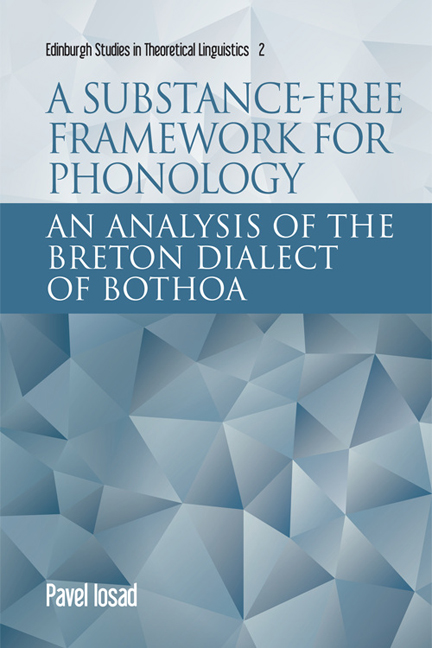Book contents
- Frontmatter
- Contents
- Acknowledgements
- Chapter 1 Introduction
- Chapter 2 Conceptual foundations of substance-free phonology
- Chapter 3 Representational assumptions
- Chapter 4 Computational assumptions
- Chapter 5 Complexity and markedness in substance-free phonology
- Chapter 6 The Breton language
- Chapter 7 Segments and representations
- Chapter 8 Suprasegmental phonology
- Chapter 9 The phonology of vowels
- Chapter 10 The phonology of consonants: palatalisation and gliding
- Chapter 11 Laryngeal phonology
- Chapter 12 Conclusion
- References
- Index
Chapter 3 - Representational assumptions
Published online by Cambridge University Press: 20 December 2017
- Frontmatter
- Contents
- Acknowledgements
- Chapter 1 Introduction
- Chapter 2 Conceptual foundations of substance-free phonology
- Chapter 3 Representational assumptions
- Chapter 4 Computational assumptions
- Chapter 5 Complexity and markedness in substance-free phonology
- Chapter 6 The Breton language
- Chapter 7 Segments and representations
- Chapter 8 Suprasegmental phonology
- Chapter 9 The phonology of vowels
- Chapter 10 The phonology of consonants: palatalisation and gliding
- Chapter 11 Laryngeal phonology
- Chapter 12 Conclusion
- References
- Index
Summary
This chapter lays out the representational system used in the book, which is a version of the Parallel Structures Model (PSM) of feature geometry (Morén 2003, 2006, 2007; Krämer 2009; Youssef 2010, 2015; Iosad 2012a; Uffmann 2013) that incorporates the insights of Modified Contrastive Specification (e.g. Dresher et al. 1994; Dyck 1995; Ghini 2001a, 2001b; Dresher 2003, 2009; Hall 2007; Mackenzie 2013). More specifically, I use the PSM, which is based on privative features, and adapt it to the Successive Division Algorithm (SDA). Dresher (2009) concentrates on a version of the SDA with binary features, but see Ghini (2001a, 2001b), Hall (2007), and Cowper and Hall (2014) for applications of the SDA to privative features. I show that this version of the PSM combines the advantages of classic feature geometry (correct grouping of features that behave as a unit, explicit tier structure), language-specific contrastive specification (adherence to the Contrastivist Hypothesis), privative features (economy, non-stipulative expression of markedness relationships), and binary features (surface ternarity in phonology).
The Parallel Structures Model
The Parallel Structures Model of feature geometry, proposed originally by Morén (2003), is based on unary features and an elaborate geometric structure that builds on the achievements of several previous theories. In its consistently privative approach to featural structure, the PSM is related to Particle Phonology (Schane 1984), Dependency Phonology (Anderson and Ewen 1987; Ewen 1995), and Element Theory (e.g. Harris 1994; Harris and Lindsey 1995; Backley 2011). The recursion of organising nodes and the overall outlines of the treatment of place are inherited from Unified Feature Theory (Clements 1991a, 1991b; Clements and Hume 1995), while the treatment of manner has important points of contact with work such as that by Lombardi (1990) and Steriade (1993).
The organising principle of the PSM is economy. It is a minimalist theory, relying on a very small number of architectural assumptions to derive universals of subsegmental organisation, such as tier organisation, node recursion, and a small number of privative features. As discussed in section 2.5, this has the consequence that the number of such universals is rather small in a substance-free theory, since the phonetic realisation of PSM structures is not the job of the phonology. Nevertheless, the PSM does disallow some non-trivial classes of potential interactions between phonological objects.
- Type
- Chapter
- Information
- A Substance-free Framework for PhonologyAn Analysis of the Breton Dialect of Bothoa, pp. 36 - 44Publisher: Edinburgh University PressPrint publication year: 2017

